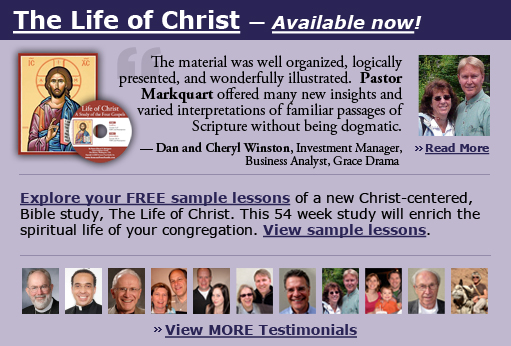
Series B
The Passion Story - Gospel Analysis
Part 5: The Crucifixion and Burial
Mark 15:22-47
The following Bible study is from a larger course entitled, THE LIFE OF CHRIST: A Study in the Four Gospels. This 54 week course for the laity will be available for congregations in 2006.
Basic text for the course: SYNOPSIS OF THE FOUR GOSPELS, Kurt Aland, English Edition, P. 276-324.
#344. The Crucifixion
Matthew 27:33-37, Mark 15:22-26, Luke 23:33-34, John 19:17b-27
-Then he handed him over to them to be crucified.
Crucifixion was the Roman means of execution and it was excruciatingly painful. The Roman soldiers would have expected Jesus to spit out obscenities and violent epithets during his crucifixion. One Roman philosopher, Seneca, said that all people, when being crucified and nailed to the cross, cursed the day they were born, cursed their mothers and cursed their executioners. They cursed everybody. Another Roman philosopher, Cicero, said that the cursing was so painfully violent that the soldiers often cut out the tongues of men who were being crucified, because their language was so filled with insane rage and hatred. The soldiers were expecting Jesus to cry out with foul-filled language. Instead, we hear not a word of raging hate from the lips of Jesus on the cross.
During this lesson, we will focus on the seven last words of Christ from the cross. The cross becomes his throne, and his royal words echo through the centuries. The cross a throne? What an anomaly!
The cross (and the crucifixion) has become the primary symbol of the Christian faith. The cross symbolizes both the death and the resurrection of Jesus Christ, his humanity and divinity. No other symbol has captivated the imagination of Christians through the centuries as the cross.
PAINTING AND IMAGINATION: THE CROSS
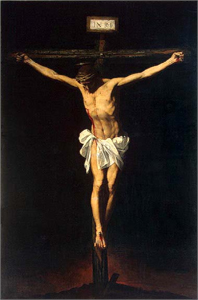
CANO
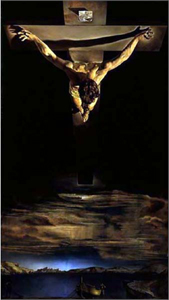
DALI
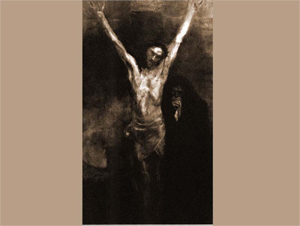
CARRIERE
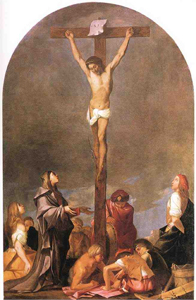
CARPIONI
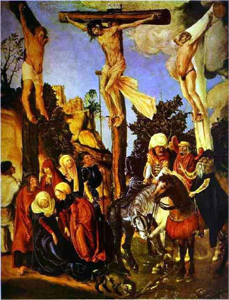
CRANACH
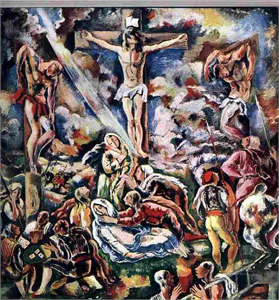
DUFRESNE
In the website, http://perso.wanadoo.fr/maurice.lamouroux/files/ill_e%20NT2.htm, a person can examine 187 paintings of the crucifixion. The crucifixion/cross is the primary symbol of the Christian faith and consequently there are numerous paintings of this central event.
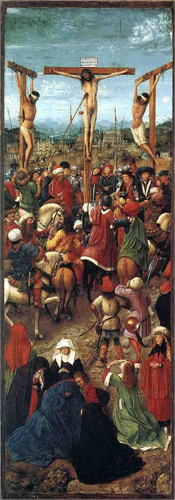
by JOE ZIAS http://www.joezias.com
Undoubtedly, one of the cruelest and most humiliating forms of punishment in the ancient world was, according to ancient sources, crucifixion. The Jewish historian Josephus best described it following the siege of Jerusalem by the Romans in AD 66-70 as "the most wretched of deaths."1 Whereas in Seneca's Epistle 101 to Lucilius, he argues that suicide is preferable to the cruel fate of being put on the cross.
This form of state terror was widespread across the Roman Empire which included Europe, North Africa and Western Asia. It originated several centuries before the Common Era and continued into the fourth century AD when the practice was discontinued by Constantine, the emperor of Rome. While its origins are obscured in antiquity, it is clear that this form of capital punishment lasted for around 800 years and tens if not hundreds of thousands of individuals were subject to this cruel and humiliating death. Mass executions in which hundreds and thousands died – such as the well known crucifixion of 6,000 followers of Spartacus as part, of a victory celebration along the Appian Way in 71 BCE – appear in the literature
THE CRUCIFIED MAN FROM GIV'AT HA-MIVTAR
In 1968 building contractors working in a suburb north of Jerusalem accidentally uncovered a Jewish tomb dated to the first century after the death of Christ.6 Lying in a Jewish ossuary bearing the Hebrew inscription 'Jehohanan the son of HGQWL' were the skeletal remains of a man in his twenties, who had been crucified. The evidence for this was based on the right calcaneum (heel bone) of the individual, pierced by an iron nail 11.5 cms. in length. The nail penetrated the lateral surface of the bone emerging on the middle of the surface in which the tip of the nail had become bent. The bending of the tip of the nail upon itself suggests that after the nail penetrated the tree or the upright it may have struck a knot in the wood thereby making it difficult to remove from the heel when the victim was taken from the cross.
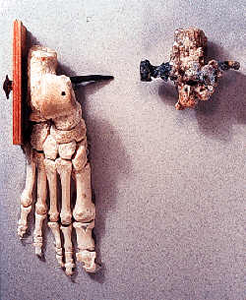
Remains of olive wood found between the head of the nail and the heel bone suggest that prior to penetrating the heel bone the nail was driven through a wooden plaque so as to increase the head of the nail thus making it difficult for the victim to free his legs from the upright. Due to the taphanomic process which occurred over a period of 2,000 years the skeleton was in a poor state of preservation. Being friable and fragmentary, with many postmortem breaks, the right heel bone was not amenable for proper anthropological investigation.
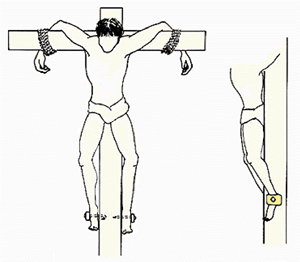
This near total absence of any direct anthropological evidence for crucifixion in antiquity bears the question of why, aside from the case described above, is the record silent. There are two possibilities which may account for this silence, one is that most victims may have been tied to the cross. In Christian art, the Good and the Bad thieves are depicted as being tied to the cross despite the fact that the Gospels do not go into detail as to how they were affixed to the cross. Scholars have in fact argued that crucifixion was a bloodless form of death because the victims were tied to the cross.”
The following comments are similar and are made by Suzanne de Dietrich, a theologian. “The story of the crucifixion is one of remarkable restraint. It refrains from trying to describe the agony of Jesus. But it does indicate in some brief touches the indifference, the cynicism and the irony of those who watched him die.” (de Dietrich, MATTHEW, The Layman’s Bible Commentary, V. 16, p. 146)
The New Testament account of the crucifixion is one of remarkable restraint. The word, “scourging,” is used only in one scene in the story of Jesus. If a person wants to discover the awful details of scourging, that person needs to read history books of the Roman Empire or see cinematic recreations of the event. The words, “nail,” or “nails” are not used once in the actual story of Jesus’ crucifixion. The nails are found later in a resurrection story about doubting Thomas and his need to see the nail marks in Jesus’ hands and the spear mark in Jesus’ side. John 20:24, “But he said to them, ‘Unless I see the mark of the nails in his hands, and put my finger in the mark of the nails and my hand in his side, I will not believe.’ The gory details of the crucifixion and the nails penetrating the human flesh are left to be discovered through human imagination. Such graphic and gory descriptions are not found in the gospel accounts.
See also Luke 24:39, where the resurrected Jesus appeared to his disciples: “Look at my hands and my feet; see that it is I myself. Touch me and see; for a ghost does not have flesh and bones as you see that I have.’ And when he had said this, he showed them his hands and his feet.”
In the Gospel of Luke, Jesus refers to his hands and feet. In the Gospel of John, Jesus refers to his hands and side.
From A Sermon:
“As happened at other Roman crucifixions, the Roman soldiers whipped Jesus. We know from history books that those crucified received thirty-nine lashes across their backs. If you can imagine a man’s back that has been whipped or lashed thirty nine times (a Jewish law but not a Roman law), it was not a pretty sight.
Jesus was then given a long wooden bar, about six feet long. The cross of execution was shaped like a letter “T.” The vertical post was stuck in the ground. The person being executed would carry only the horizontal top of the “T,” a six-foot board like this one. This six-foot board would be attached to the top of the vertical wooden pole stuck in the ground. The cross in the shape of a T is called a Tao Cross, pronounced “Dow” cross.
After receiving the thirty-nine lashes, Jesus and other criminals would carry this heavy piece of wood through the streets of Jerusalem, narrow winding streets that were about twelve feet in width. It was about a ten-minute walk from the place where Jesus was sentenced to the Place of the Skull outside the city wall. It was a ten-minute walk if there were not crowds, but on that day, the crowds were crushing against one another as a badly whipped Jesus slowly carried that top piece of the cross to the place of his execution, the Place of the Skull. Jesus was so exhausted by the pain that someone, a Simon of Cyrene, was picked from the crowd to carry the cross for him.
Jesus finally came outside the city wall to that cliff; with the eye sockets carved into the mud walls and those eye sockets made the cliff look like a skull. There was flat ground below the cliff and the limestone gravesite directly above the cliff. Jesus came to that place of the skull.
The Roman soldiers then stripped him bare naked and then placed the cross bar on the top of the upright, vertical beam. The soldiers lifted the body of Jesus onto the cross. There was a small saddle of wood where they would put his buttocks. The soldiers then took some ropes and tied Jesus around beneath the arms and tied his body to the cross so he wouldn’t fall. With long heavy ten-inch spikes, they nailed his wrists/arms, not the palms of his hands as is in all medieval paintings, to the cross, so he also hung by his wrists. They also nailed his feet to the bottom of the cross. Jesus was left hanging there in agony, having no clothes, stark naked. The watchers made fun of him. There was no way he could control his bodily functions. There was no way he could get rid of the flies. There was no way he could get down. And so Jesus and the other robbers would hang there for days until they died of exhaustion and suffocation. Normally, convicted criminals died of suffocation as their lungs collapsed.
Today, two thousand years later, there is still a fascination with the cross. People still want to hear the story of the cross and still want to hear the absurdity that the cross is the throne of Christ and that Christ still rules from the cross.
Why? Why? Tell me why the crowds were so quiet above the Place of the Skull? Why is it that two thousand years later we still want and need to hear the story of the cross? Is it because we are human animals? We like to see violent pieces of art, in the same way that people want to go to the races in order to see nasty accidents and the nastier the car wreck, the better? Or is our fascination with the cross similar to our being fascinated with boxing matches and football games and people enjoying the “big hit?” Are we fascinated with the cross because we are sadistic? Why? Why are we drawn to Golgotha? Why is there a magnetism to this place? Why do people speak only in hushed whispers?
Intuitively, we sense that the cross is the central symbol of the Christian faith. We are drawn to the cross because we sense that the cross is the key that unlocks the whole Christian faith. The cross is the key that unlocks the mystery of God. The cross is the key that unlocks the mystery of our lives. We sense that in the cross.
The cross is the one strongest and most central symbol of the Christian faith, symbolizing both the death and resurrection of our Lord Jesus Christ. The cross symbolizes the love of God through pain and suffering; the cross also triumphantly symbolizes the resurrection to new life forever. Good Friday and Easter. The tragedy and the triumph. The humanity and the divinity. Both eternal messages are in the cross.
The cross? It is the throne of Jesus Christ. How absurd but Christians have believed that for centuries. Christ is king and the Gospel of John tells us that when he was crucified, he was glorified.
The cross? It is the pulpit from which Christ preached his most powerful sermon of seven words. Most people think that finest sermon of Jesus was the Sermon on the Mount, but we discover that the finest sermon of Jesus was the one he gave from the cross when he was in the midst of pain.
The cross? It is the window through which I see the face of a loving God. You see, it is only in the cross that you see the face of God. I look into the cross and the cross becomes a window through which I see the face of a loving God. O, I look into the sun and I see the energy of God. I look into the stars and see the infinity of God. I look at the atoms and see the complexity of God. But it is only in the cross that I see the face of God’s love. It is only in the cross that I see a love so great that God was willing to die for me. It is only in the cross that I hear the statement, “no greater love is this, than a person is willing to lay down his life for his friend.” There is no greater love than a person is willing to die for another, and the cross states all this.
The cross? The cross became Jesus’ throne through which he gave his most powerful sermon in demonstrating his love for his tormenters. The cross became Jesus’ throne from which he gave his most powerful teachings and sermon. The sermon from the cross was even more profound than the Sermon on the Mount.
The Sermon of the Mount was an enormously favorite sermon, and it is found in Matthew 5-7. The setting was beautiful there on the mountain hills above the Sea of Galilee with the rolling green grass, flowers and butterflies. He preached about the beatitudes and the blessings, the golden rule and the Lord’s Prayer, the birds of the air and the lilies of the field. I suspect when he was finished preaching, the people gave him an ovation, perhaps even a standing ovation. That sermon was great.
The sermon from the cross was just the opposite. This sermon from the cross was at the end of his ministry. All the crowds had disappeared. All the disciples but one had disappeared. The popularity had disappeared. The positive preaching about happiness, the golden rule and prayer had disappeared. There was no talk about the birds of the air and the lilies of the field. The warm sunshine and green grass had disappeared. The green grass and Sea of Galilee were no longer in view. There was no talk about happiness.
These seven words of Jesus were spoken from the cross at Golgotha when Jesus was in enormous pain and dying, pain from the thirty-nine whips lashes across his back. Pain from being on the cross for three hours, from noon until three o’clock on that Friday afternoon. The name of the place that he was executed was called Golgotha, the place of the skull.”
End of this portion of a sermon.
-So they took Jesus; and carrying the cross by himself, he went out to what is called The Place of the Skull, which in Hebrew is called Golgotha. In Latin, the Hebrew word for Golgotha is translated Calvary. We may recall the words from the old hymn, “Come to Calvary’s Holy Mountain.”
Pictured below is a photograph of a place outside the walls of Jerusalem. The photograph may be of the hillside/cliff which was named Golgotha, the place of the skull.
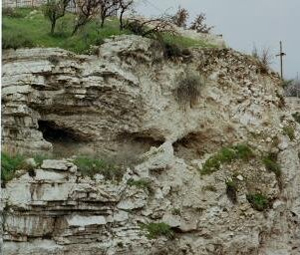
From a sermon:
“Use your imagination. Outside the walls of Jerusalem, I would say about 250 yards northeast of the old wall, or about 250 yards northeast of the Damascus Gate, is a rather large cliff. This tall cliff is about sixty feet high. It seems to be made of old gray clay, embedded with rocks. In that cliff, 250 yards outside the old city wall, in that cliff are large indentations, three large indentations, almost like sockets, almost like eye sockets. They look almost like the face of a skull, if you use your imagination. It seemed to me there is a face of a skull in that cliff, with three large holes, looking like eye sockets and a mouth. I saw the shape of the skull with my own eyes. At the bottom of that cliff, there is a flat piece of ground. It is now a parking lot for buses. The tourist guides say that this parking lot at the foot of the cliff was the place of Jesus’ execution on the cross. Right there, beneath this cliff, was perhaps the location of Golgotha.
It was about 1920, and there was a man by then name of Dr. Gordon who had been looking for the Place of the Skull. Dr. Gordon was an archeologist. For sixteen centuries, people had believed that the place of Jesus’ crucifixion was inside the center of the city of Jerusalem, where the Roman empress, Mother Helena, had built a gorgeous palace for Christ. It was called the Holy Sepulcher. The Holy Sepulcher was crafted of gilded gold, baroque style, and very ornate. This Holy Sepulcher had become one of the most sacred shines of Christianity. I had the privilege of visiting that ornate temple in the center of the city.
But Dr. Gordon realized that a crucifixion could not have occurred in the city walls; a Roman crucifixion would not have been permitted in the city walls of Jerusalem. So Dr. Gordon, a British soldier and archeologist, began looking for the Place of Execution outside the city walls. One day, after twenty years of searching, he had searched enough and was going to finally give up looking for the Place of the Skull. He was sitting in his villa about five o’clock in the afternoon, and he saw massive shadows on this cliff across the valley floor. He saw those eye sockets and his imagination went to work and he saw what he thought may be the Place of the Skull. Upon further investigation, above that sixty foot cliff, was a large flat area, now a beautiful garden, about half the size of a football field. In that beautiful garden, were and are currently old olive trees and giant, old, old plants. Also in that garden above the cliff is an ancient tomb carved out of limestone. In front of that tomb, believe it or not, there is a trough or trench, dug out by human hands centuries ago. In that trough or trench, is where a circular burial stone was rolled, to seal the burial cave. To the archeologists, this was obviously an ancient burial site, an ancient tomb, an ancient gravesite. Gradually, most scholars have come to the conclusion that this was perhaps the authentic site where Jesus was crucified and buried. It fits the Biblical record very well: outside the city wall, close to the city, near a place called “The Skull,” with a garden tomb nearby. John 19:41 “Now in the place where he was crucified there was a garden and in the garden a new tomb…where Jesus was buried.” The stories of Good Friday and Easter occur geographically right next to each other.”
(End of this portion of a sermon.)
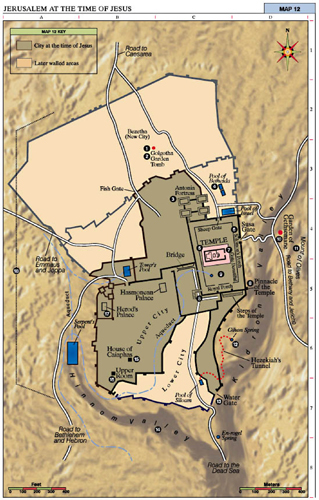
- And they offered him wine mixed with myrrh; but he did not take it. (Mark, Matthew)
-There they crucified him, and with him two others, one on either side, with Jesus between them.
- Then Jesus said, ‘Father, forgive them; for they do not know what they are doing.’ And they cast lots to divide his clothing. (only Luke) This is the first of Jesus’ seven words or teachings from the cross. Write these words next to this saying: “The first of the seven words from the cross.”
This first word from the cross reveals pure grace. This may be the most powerful example of forgiving love in the whole Bible. While in so much pain, he asked God to forgive his tormenters. In the Sermon of the Mount, forgiveness is present but hidden. Here on the cross, the forgiveness of God is written in blazing letters with a fanfare of blaring music for all people to see and hear. The soldiers didn’t ask for forgiveness; they didn’t deserve it; but Jesus gave them forgiveness. They didn’t even ask. This was pure grace.
Circle the word, “Father.” Jesus’ choice of the word, “Father,” reveals his closeness to God. As in all of Jesus’ prayers, he never addressed God as Lord, King of the Universe, Omnipotent Ruler of the Heavens. The distinctiveness of Jesus’ prayer life was to call God intimately by name, by the word, “Father.” One Biblical scholar says that Jesus’ whole life can be summarized by that one intimate word, “Father.” Jesus was the first person in the Bible to use the familiar equivalent of “dad” or “daddy” to begin his prayer life. In our prayer lives, Jesus taught us to address God closely and warmly as we would when talking to our mom or dad.
Circle the word “forgive.” Rather than calling on God to damn and punish those people below who were crucifying and killing him, Jesus’ heart was full of compassion for them, rather than rage. The normal thing was to swear, curse, use foul language at his tormenters but Jesus’ heart was just the opposite. Jesus called out for God to forgive his tormenters rather then to punish them.
I would imagine that having forgiveness for people who are killing you is not easy. It is not easy to love our enemies and cruel people. It is comparatively easy to forgive our friends during an argument or forgive our parents for acting “so ridiculously” or forgive our children for doing stupid things. That kind of forgiveness is somewhat easy. But it is not easy to forgive our enemies and those people who kill you. That was not easy for Jesus. But that is what Jesus did from the cross. Jesus loved those who were hurting him and killing him. That is what is amazing. To love our enemies is a miracle from God.
Underline the phrase, “for they know not what they do.” The soldiers around the cross didn’t really know that they were crucifying the very Son of God. The religious leaders did not really comprehend that they were plotting against the very Presence of God. The gawkers did not realize that they were watching the most loving human being of all time being killed. They didn’t get it. And likewise with us today. We “don’t get it.” We don’t feed the hungry of the world and they die of starvation while we all eat well and we don’t “get it” that we are ignoring Christ who lives within the bodies of starving children. We don’t visit the old folks homes in our neighborhoods and those elderly people slowly die of loneliness while we are too busy and we “don’t get it” that we are neglecting Christ who lives in the bodies of our aging elderly friends. It is not the sins of commission that really bother us; it is the sins of omission that really get to us. And we don’t know what we are doing.” (End of that portion of the sermon)
- (They) divided his clothes among them, casting lots to decide what each should take. (Mark, Matthew, Luke) The soldiers rolled the dice to see which soldier got which garment that had been taken from Jesus. From the Gospel of John, we will hear that there were four soldiers and four pieces of clothing were divided among them. In John, the soldiers caste lots for the seamless tunic that Jesus had worn.
-It was nine o’clock in the morning when they crucified him. (only Mark). Traditionally, Jesus hung on the cross for three hours, from nine in the morning until noon when he died. This reference to 9:00 in the morning in Mark’s gospel is the source of the tradition that Jesus was put on the cross at 9:00 A.M.
-Pilate also had an inscription written and put on the cross. (The remainder of this section of Scripture comes from the Gospel of John.)
-It read, ‘Jesus of Nazareth, the King of the Jews.’ This is the issue. That is why Pilate allowed Jesus to be killed even though Pilate knew that Jesus was innocent of any crimes against the Roman state.
-Many of the Jews read this inscription, because the place where Jesus was crucified was near the city; For centuries, Christians tried to locate the site of Jesus’ crucifixion. For centuries, Christians thought that the place of execution was inside the city walls such as at the site of the Holy Sepulcher with its gilded gold canopies and its garish baroque architecture right in the middle of the city.
-And it was written in Hebrew, in Latin, and in Greek. These were the three languages of Jesus’ day.
-Then the chief priests of the Jews said to Pilate, ‘Do not write, “The King of the Jews,” but, “This man said, I am King of the Jews.”’ The chief priests were the culprits; they were the ones who wanted to get Jesus killed in the first place. And they didn’t want people to think that Jesus was actually king of the Jews. For the chief priests to confront Pilate, they must have left the Place of the Skull and walked back to the Praetorium and spoke to Pilate about getting the sign changed. It does not seem reasonable that Pilate was at the place of execution.
-Pilate answered, ‘What I have written I have written.’
-When the soldiers had crucified Jesus, they took his clothes and divided them into four parts, one for each soldier. Write down in the margin, “There were four soldiers.”
-They also took his tunic; now the tunic was seamless, woven in one piece from the top. So they said to one another, ‘Let us not tear it, but cast lots for it to see who will get it.’
-This was to fulfill what the Scripture says, ‘They divided my clothes among themselves, and for my clothing they cast lots.’ And that is what the soldiers did. The Gospel of John, even though it is not Jewish like the Gospel of Matthew, still refers to the events that happened to Jesus as fulfilling prophecies from the Old Testament.
-Meanwhile, standing near the cross of Jesus were his mother, and his mother’s sister, Mary the wife of Clopas, and Mary Magdalene. Jesus’ biological family was there at the foot of the cross: his mother, his aunt, and his cousin. We know that three Marys were present at the foot of the cross: Mary the mother of Jesus, Mary Magdalene, and Mary the wife of Clopas. A fourth woman, the sister of Jesus’ mother, was also there. Her name was Salome and her sons were John and James. Mary and Salome were sisters, and that makes Salome the aunt of Jesus and that makes John to be the first cousin of Jesus. So Mary had her sister there, and her sister was the mother of John the disciple who was also there. John is the “disciple whom Jesus loved” and is the eyewitness who authored the Gospel of John. John is the only disciple at the foot of the cross; all of the other disciples had run away. So both John and his mother were at the foot of the cross.
Let us briefly review the signs that Mother Mary received about Jesus. We all receive signs, small evidences about other people or ourselves. These signs are clues that reveal the truth.
Mary’s first sign or clue was this. We remember the first story about Mary when the angel Gabriel came and told her that she would become pregnant by the Holy Spirit and give birth to the savior of the world. And what was young Mary’s reaction, as a fifteen year old girl? “With God, nothing is impossible. I am a servant of the Lord. I believe.” And so we are reminded that Mary was a devout young Jewish woman who deeply believed in God, that nothing was impossible with God, even that she could become pregnant by the Holy Spirit. I personally believe that Mother Mary was the first human being on earth who believed in Jesus as the Son of God.
And then there was that second sign or clue when she was in the temple, dedicating Jesus to God, and an old man by the name of Simeon came up to her and said, “a sword will pierce your soul and the hearts of many people will be revealed.” Mary pondered these things. She would have questioned: “What does it mean that a sword will pierce my heart?” Like so many things deeply buried in the recesses of her mind, Mary remembered the warning by the old man Simeon that a sword would pierce her heart before “it” was all over. This was the first omen to her that her son would die a murderous death.
The third sign or clue. Mary was with Jesus when he was in the temple at age twelve and he said, “I must be about my Father’s business. I must be in my Father’s house.” The Bible said that she pondered and remembered these things, that Jesus knew that his real father was not Joseph but the Holy Spirit.
A fourth sign or clue. Mary was with Jesus when Jesus did his first miracle, turning the water into wine at a wedding feast. Mary seemed to push Jesus into doing his first miracle, and Jesus seemed hesitant. It seems, by reading this story in John 2, that Mary had a glimmer of Jesus’ true identity. After this miracle, the disciples first believed in him. Mary believed in Jesus’ from his birth; the disciples believed in Jesus after this first sign. Mary believed in Jesus before the disciples did.
A fifth sign or clue. Mary and her children came to see Jesus and someone reported to Jesus that his mother and brothers were there. Jesus replied, “Those who do the will of God are my true brothers, sisters and mother.” Mary would have nodded in agreement. The true family was Jesus are those who do the will of God.
A sixth sign or clue. Mary was with Jesus at the foot of the cross. This would have been the most awful and gut wrenching experience of her life, to see and experience his crucifixion on the cross. The sword that pieced his side could have just as well pierced her side. Jesus’ pain was her pain. That is the way it is with mothers. I have known and watched many mothers during my life as a pastor, and I have watched such mothers when their children are deathly sick and suffering. It is always the same: the mother totally feels the pain of her child, and Mary totally felt the excruciating pain of Jesus. … Mary’s best friends and sister were there with her, but their love and compassion did not diminish the sadness and agony she was feeling. Her friends and sisters shared her grief, but her grief was not lessened. You could not keep Mary away from the awfulness of the crucifixion, and that is just the way deeply loving mothers are. They are present to face the deepest pain of life of their children.
In the movie, THE PASSION, the director, Mel Gibson, gives Mary, the mother of Jesus, an inordinate and omnipresent role. Gibson recreates several scenes for Mother Mary. Several of these scenes are apocryphal or legendary, reinforcing some of the basic biases from Gibson’s “Old Catholic” past. If a student remains within the Biblical record of Mother Mary, there is much to be learned from her. It is not necessary to create apocryphal, extra-Biblical legends about her. On the other hand, Mary’s person and role in Gibson’s, THE PASSION, were touching and had a feel of authenticity to them.
Discussion Question:
What do you think were some of Mother Mary's feelings when she was watching her son being crucified? |
-When Jesus saw his mother and the disciple whom he loved standing beside her, he said to his mother, ‘Woman, here is your son.’ John is the only disciple on the scene. The rest had run away. As we have said previously, John describes himself in his gospel, not by his name, but by the phrase, “the disciple whom Jesus loved.”
This is the second of the seven last words from the cross. Write that in the margin of your book: “the second word.”
-Then he said to the disciple, ‘Here is your mother.’ And from that hour the disciple took her into his own home. Jesus entrusted his mother to the care of John who took his mother into his own home. Underline the words, “took her into his own home.” When you take someone into your own home, that says much about a person. John later teaches us about love and love is not merely to love with words and language but in deed and actions. By taking Jesus’ mother into his home, this reveals that John was to take care of the little, almost invisible needs of Mary day by day.
Also remember that John was then caring for his Aunt Mary because she was his own mother’s sister. Love and compassion was within the family circle.
Compared with the love he had for other friends around him, Jesus had the longest and deepest loving relationship with his own mother, Mary, and he wanted his mother taken care of in the best way possible. For Jesus, John was the person who would take care of his mother better than anyone else. Jesus knew that John could be trusted with this sacred obligation.
We discover that John was at the foot of the cross when all the other disciples had run away. That may mean that John was more courageous than all the other disciples. Or it may mean that he loved Jesus more than all the other disciples. I tend to believe the latter: that is, John was there at the foot of the cross, not simply because he was more courageous, but because his love for Jesus was deeper and more authentic than the other disciples.
And Jesus said to his best friend and his first cousin, John, who was with him at the end, “Take care of my mother.” John did. John tells us in his Gospel of John, in his account of the story of Jesus, that he John took Mary into his own home and cared for her from that day on.
Jesus’ other biological brothers were not there at the cross. It seems that the next oldest brother in Jesus’ family, James, should have been the one who would take care of his mother, but James and the other brothers (and sisters) were not at the cross of crucifixion that day. Jesus knew who loved him the most and that person was John. John would be the best choice to take care of his mother in the future.
What can we learn from the best friend of Jesus, John? We learn that “best friends” love through thick and thin, from the highest to the lowest points of life. And when life is the lowest, best friends are there, and John was there. I see that very often in my world. Life is at the lowest and the most painful and best friends are there to share the grief. That is the way it is with best friends. In fact, you can count your best friends by counting those who are with you at the worst and lowest moments of your life.
Jesus asked John to care for his mother in the future, and John did that. We find that Mary and John were together in the Upper Room when the Holy Spirit was given to the church in Acts 1 and 2. We also discover that Mary and John traveled to live in Ephesus. Temples were built in Ephesus to honor both Mary and John, indicating their shared lives in that city. I am suggesting to you that Mary and John, the two people who loved Jesus most here on earth, took care of each other until their dying day, just as Jesus had asked them to.
#345. Jesis Derided on the Cross
Matthew 27:38-43, Mark 15:27-32a, Luke 23:35-38
-And with him they crucified two bandits, one on his right and one on his left.
Those who passed by derided him, shaking their heads and saying, The gawkers and the those passing by were the first group of people taunting Jesus.
-‘Aha! You who would destroy the temple and build it in three days, 30save yourself, and come down from the cross!’ Jesus had taught that the temple would be destroyed and then rebuilt in three days but he was referring to his body and not the physical temple erected by Herod the Great. This was another example where Jesus was teaching about a spiritual truth and his hearers misunderstood what Jesus had said. This is another example of Jesus knowing about both his death and resurrection prior to the events.
-In the same way the chief priests, along with the scribes, were also mocking him among themselves and saying, The chief priests and scribes, the culprits behind the crucifixion, were part of the scene, still taunting and mocking Jesus.
-‘He saved others; he cannot save himself. Let the Messiah, the King of Israel, come down from the cross now, so that we may see and believe.’ This is mockery. The chief priests did not really believe that Jesus was the King of Israel nor that he would come down off the cross nor that he would escape his agony with some miraculous trick.
- He trusts in God; let God deliver him now, if he wants to; for he said, “I am God’s Son.”’ (Only Matthew) The Scriptures are clear that Jesus was/is the Son of God. Matthew makes this statement even more clearly at this moment in the narrative.
-The soldiers also mocked him, coming up and offering him sour wine, The soldiers were another group in this scene who mocked Jesus.
-And saying, ‘If you are the King of the Jews, save yourself!’
-There was also an inscription over him, ‘This is the King of the Jews.’
#346. THE TWO THIEVES Luke 23:39-43
-This longer section is only found in the Gospel of Luke. Mark and Matthew only have one line.
- One of the criminals who were hanged there kept deriding him and saying, ‘Are you not the Messiah? Save yourself and us!’
-But the other rebuked him, saying, ‘Do you not fear God, since you are under the same sentence of condemnation? And we indeed have been condemned justly, for we are getting what we deserve for our deeds, but this man has done nothing wrong.’
-Then he said, ‘Jesus, remember me when you come into your kingdom.’
-He replied, ‘Truly I tell you, today you will be with me in Paradise.’ This is the third of the seven last words from the cross, the throne of Jesus Christ. The cross has become his throne from which Jesus speaks powerfully and meaningfully. In the margin of your text, write down: “the third word.”
The concept of paradise is found in the beginning of the Bible, at the end of the Bible and in the middle of the Bible.
The Bible begins with stories about paradise. In the Old Testament, paradise is the Garden of Eden. The Greek word for paradise sounds like our English word for paradise. The Greek word for paradise sounds like “paradaysos” from which we get our English word “paradise.” The Greek word, “paradise,” simply means a garden, and in the second and third chapters of Genesis, we hear often about God’s paradise, God’s Garden of Eden. We hear that God planted the garden, and put a man in that garden. God then planted trees for beauty and food. God also planted two exotic species of trees in that garden paradise, the tree of life. If you ate of that tree of life, you would live forever. The second exotic tree in the middle of the garden was the tree of the knowledge of good and evil. If you ate of that tree, you would know both good and evil. Adam and Eve did.
The Bible also ends with paradise. At the end of the Bible, we also encounter paradise. We discover the eternal city of God, the eternal paradise of God. Paradise is described as being a heavenly city with streets paved with gold and with pearly gates. All the animals and all the kings and all the people are praising God. We also discover that there is no snake (evil) in paradise and there is no tree of the knowledge of good and evil in paradise. In paradise in the last book of the Bible, evil has been destroyed and there will be no more pain and no more crying and no more death. And paradise will last forever and ever and ever and ever. You have only one tree in paradise: the tree of life, the tree of everlasting life.
So paradise is found at both ends of the Bible, in Genesis and in Revelation. In the middle of the Bible, between Genesis and Revelation, we hear Jesus’ words about paradise today from the cross. Jesus makes a gigantic promise to the robber next to him on the cross.
Today. Circle the word, “today.” Today, not tomorrow, not in a thousand years or a thousand hundred years, not after the rapture but before the millennium. No. Immediately, you will be with me in paradise with Jesus. When you die or your loved one dies, you are with Jesus in paradise immediately.
You. Circle the word, “you.” The word, “you,” refers to the thief but it also refers to you and me and our loves ones and innumerable others. We are part of that “you.” Write down near the word, you: “Me also.”
With me. Circle the words, “with me.” The persistent theme of the Bible is not that we will join our loved ones in heaven but that we will join Jesus/God in heaven. In funerals today, it is emphasized that we will join our loved ones in heaven, but the Bible is much clearer that we will be reunited with Christ in paradise. Near “with me,” write down the word, “Jesus.”
In paradise. Circle the word, “paradise.” We will be with Jesus in that eternal garden where there is no more pain and sorrow and sadness, for all the former things have passed away.
“Pure grace.” Write those words into the margin. The thief did not earn paradise or deserve paradise, but paradise was a pure gift to him from Jesus. That is the way it is with us as well.
Discussion Question:
What do Jesus' words mean to you, 'today you will be with me in paradise?'
|
#347. The Death of Jesus
Matthew 27:45-54, Mark 15:33-49, Luke 23:44-48, John 19:28-30
-When it was noon, darkness came over the whole land until three in the afternoon. In the movie, THE PASSION, Gibson pictures the land become very dark at this moment due to an intense cloud cover and storm moving into Jerusalem.
-At three o’clock Jesus cried out with a loud voice, ‘Eloi, Eloi, lema sabachthani?’ which means, ‘My God, my God, why have you forsaken me?’ This is the fourth word of the seven last words from the cross, the throne of Jesus Christ.
“What can we learn from Jesus’ cry, “eloi, eloi, lema sabachtani,” to God? It means, “My God, my God, why have you forsaken me?”
The first thing we learn is this: It is OK to have feelings and vent those feelings of abandonment, as Jesus did on the cross. To feel the pain and sadness of being abandoned by God is normal. That is the way God made us, to feel such feelings and to vent such feelings. It is OK to feel depressed and abandoned by God.
King David certainly did, when people wanted to kill him. King David wrote those classic words in Psalm 22:1, “My God, my God, why have you forsaken me?” King David was a devout believer in God and clung to God and was loyal to God, but he also felt depressed and abandoned by God and he vented his feelings to God. If it was normal and acceptable for King David, the best king in the Old Testament, to feel his feelings and to vent his feelings, it is certainly normal and acceptable for you and me to feel the same way.
Job certainly did. Job is the most famous person in the Old Testament who is known for his suffering. Job suffered more than any other person in the Old Testament, and he, too, felt abandoned by God, deserted by God, forsaken by God, and he shouted his laments and anger towards God. That was part of humanness, to feel that way, and it is part of our humanness to feel that way as well. It is OK for us to feel like Job.
Jesus certainly did. Jesus was the very Son of God, the heart and mind of God in the flesh, and in the moment of the deepest darkness of the land and the deepest darkness of his heart, Jesus felt that God had abandoned him and he shouted his feelings to the heavens. This reveals that Jesus was fully human. When we have those similar feelings and vent those feelings, it reveals that we are fully human as well. It is OK for us to feel like Jesus.
So when you have such feelings that God has abandoned you, and you vent those feelings, remember that you are in the good company of King David, Job, and Jesus the Son of God. When you personally lose a loved one due to death or divorce or them moving away and you feel sadness, disappointment and down in the dumps about your situation and you cry out to God with your feelings, remember that this is OK. King David did it. Job did it. Jesus, the Son of God, did it.
When we lose a father or mother, or brother or sister, or child or grandchild, or experience any tragedy in our personal lives, we often feel a silent abandonment by God. It is OK to feel that way. David did. Job did. Jesus did. We often do.
The second thing we learn tonight from Jesus’ word is this: Even in the worst situations of life, we are to cling to God with both hands as Jesus did. Please remember: with both hands. Let me explain. For me, Charles Spurgeon wrote one of the best sermons on this text. The year was 1872. Charles Spurgeon was one of the greatest preachers of all time, living in London, England. Spurgeon said that in Jesus’ darkest hour with darkness all around him and within him, Jesus still clung to God with both hands. His left hand said, “My God.” His right hand said, “My God.” Eloi. Eloi. My God, my God, was Jesus clinging to God with both hands in the midst of this horrific situation. Jesus clung to God with all his might during the darkest hour of his life…with both hands.
Spurgeon went on to say that it is easy to believe in God when life smiles on you, but it is much more difficult to believe in God when life frowns on you. It is easy to believe in God when you are wearing silver slippers and the path is smooth and easy; but it is much more difficult to believe in God when your feet are blistered and the path is rocky.
Sometimes, life can be incredibly hard. In the worst and darkest day of human history, Jesus still clung to God with both hands and held onto God. We are to cling to God in our darkest days.
What were the darkest days of human history, when the sky was blackest? Was it when 200 million people were killed by Hitler, Stalin and Mao during World War II? Was that the darkest time of human history? Or the 137,000,000 people killed by the Black Plagues in the 6th, 14th and 17th centuries? Or the 100 million people in southern Africa infected with the AIDS virus early in the twenty first century? Or the 25-30 million people killed in the United States in 1918 by a flu epidemic? Or when six million Jews were exterminated in gas chambers during World War II? What the worst day of human history? When there were more than 4,500 deaths in one day in the battle of Antietem, during the Civil War? Was it September 11th when 3,000 civilians were killed in one hour? Was it the day that the Son of God was executed? In all of those horrific tragedies, we are invited to do what Jesus did in that darkest hour: Jesus clung to God with both hands, crying out to the heavens, shouting his despair, “ My God, My God, both hands grabbing God, where are you? Why weren’t you here to protect us?”
So on God’s Friday, we find Jesus clinging to God with all his power, with both hands, and at the same time, shouting his inner feelings up to God. We are invited to do the same. Cling to God with both hands and shout our inner feelings to God in the highest.
The third quality we learn from Jesus’ word on the cross is that these were not his last words. The drama does not end with his depression and emotional exhaustion. “Why have you forsaken me?” These are not his last words, not his final words, not the end of the story.
King David wrote the 22nd psalm, “My God my God, why have you forsaken me.” But he also wrote the next psalm, the 23rd psalm, “The Lord is my shepherd I shall not want. I will dwell in the house of the Lord forever.” The 22nd psalm was not his last word.
Job complained to God when he lost all his possessions, his family, everything. He railed against God in his anger, but those were not his last words. He also wrote at the end of his book, “I know that my redeemer lives.” Job’s feelings of abandonment were not his last words.
So also with Jesus. “My God, My God, why have you forsaken me.” Eloi. Eloi. These were not his last words. His last words were “It is accomplished. It is finished. It is done.” He also said, “Into your hands I commit my spirit.”
Easter always trumps Good Friday.
Similarly, there is a famous quotation that I like. “I believe in the sun when it is not shining. I believe in the stars when I cannot see them. And I believe in God when I cannot hear him.” Those words were inscribed in on a ghetto wall in Poland during World War II.
-When some of the bystanders heard it, they said, ‘Listen, he is calling for Elijah.’
-And someone ran, filled a sponge with sour wine, put it on a stick, and gave it to him to drink, saying, ‘Wait, let us see whether Elijah will come to take him down.’
-After this, when Jesus knew that all was now finished, he said (in order to fulfill the scripture), ‘I am thirsty.’ A jar full of sour wine was standing there. So they put a sponge full of the wine on a branch of hyssop and held it to his mouth. Near the phrase, “I am thirsty,” write the words, “the fifth of the seven last words.” According to the Biblical narrative, the sour wine was lifted up to Jesus on a branch and not on the tip of a Roman spear.
Hyssop: “The identification of hyssop is not certain. That is, eighteen plants have been suggested in answering its description.” (Brown, JOHN, V. 2, p. 909) Other scholars suggest the identity of hyssop was “sorghum vulgare.” “Sorghum vulgare var. durra: During the last moments of Christ's agony on the cross his lips were moistened with a sponge filled with sour wine. The sponge was raised on a cane of dhura, referred to here as hyssop. It is a tall plant with sturdy stems that reaches a height of over six feet in maturity.”
From a sermon:
“Ten details from the foot of the cross. We recall that John, the Apostle, was the beloved disciple whom Jesus loved and was the author of the Fourth Gospel which has juicy details of numerous events from the life of Jesus. Here in this text, we hear numerous juicy details that could have been given to us only by an eyewitness such as John.
Detail 1: “Jesus knew that it was all finished.” John knew that Jesus knew it was all over. Jesus was on his last breath and he knew he was going to die any minute now. That is the way it is with some people: they know that this is their moment, their moment of truth, their moment of death, their last moment. And so with Jesus. He was merely minutes from the end of his earthly life and he knew it. And John, at the foot of the cross, knew that Jesus knew.
Detail 2. “To fulfill the Scriptures.” Throughout the whole New Testament, Jesus says and does everything to fulfill the Scriptures. Many things that he did during his life were to fulfill Scriptures and this was another one. Jesus then quotes a psalm.
Detail 3: “I thirst.” Jesus gave them a quotation from Psalm 69:31. “I thirst and they gave me vinegar to drink.” Jesus chose the exact words from Psalm 69, an obscure passage. But John the Apostle, from the foot of he cross, heard the detail, and saw it and recorded it.
Detail 4: “a bowl…. full… of vinegar … stood there.” A detail with four parts. Bowl, full, vinegar, stood there. Why? A bowl? More than a cup? Why a bowl? Why was there a bowl full of vinegar? Why was the bowl full? Could it been half full or quarter full or a little spoon of vinegar in that bowl? Why not just a little vinegar? Why vinegar? Why sour wine? Was the bowl standing on a table, on the ground? In this account, we are informed of specific details. There was a bowl…full… of vinegar…standing there. John, the apostle, at the foot of the cross, saw it all, saw the detailed images, with his own eyes.
Detail 5: “They… put a sponge… full of vinegar… onto hyssop.” A detail with four parts. A) They, B) sponge, C) full of vinegar, D) hyssop. Who were the “they?” Who did this cruelty? Most likely the soldiers. A group. There were four soldiers present, so John tells us … A sponge? Why a sponge? Who brought the sponge? How about a rag? An old shirt? …Full of vinegar? Dripping with vinegar? Why not just a little vinegar or sour wine? … How would they get that sponge full of vinegar up to him on the cross? On a branch of a bush? A branch of hyssop, a common vine at that time. It was not only a branch but the kind of bush or branch had a name: hyssop. You can actually see the details as recorded by John. You can see a sponge, see a sponge dripping with vinegar, see a sponge being lifted up to the lips of Jesus by the soldiers, on a stick from a bush, all witnessed by a man standing at the foot of the cross.
Detail 6: “They held it to his mouth.” Again, without any painting, without any movies, without any visual effects, you can see the soldiers sticking that sponge of vinegar up to Jesus’ passive lips. Not one soldier but plural soldiers. You can see them holding the sponge up to Jesus’ lips. Another detail that John say from the foot of the cross. John was carefully watching it all.
Detail 7: “And when Jesus had received the vinegar.” Again, Jesus must have sipped the vinegar, tasted it, smelled it, took a whiff of it, took some of the bitterness of the vinegar on the taste buds of his parched lips and tongue. John, seeing it up close from the foot of the cross, tells us that Jesus received the vinegar; he took it into himself.
Detail 8: Jesus said, “It is finished.” “It is finished” is the last word in John’s Gospel
Detail 9: “He bowed his head.” You can see Jesus dropping his head. His neck and head slump down in lifelessness.
Detail 10: Died, gave up his spirit. Have you even been in a room when someone slipped away and it became even quieter?
So from this scene in the Gospel of John, we see ten details about the end of Jesus’ life here on earth.” When a person reads this account of this story, you feel that you are reading the details given by an eyewitness who actually saw what happened.
-When Jesus had received the vinegar, he said, “It is finished.” (John) This is the sixth of the last words of Jesus from the cross, his throne. In Greek, it is one word, “Finished!” There is triumph to the word. Write that in your margins. Above the sentence, “It is finished,” write one word in bold letters, FINISHED! followed by an exclamation mark.
“It is finished” can mean that the Roman leaders, the Jewish leaders and the disciples thought Jesus was finished, over and done with.
But, “It is finished” can also mean, “It is accomplished.” It is accomplished, fulfilled, completed. Then one puts an exclamation point after the phrase. It is accomplished! The job is done! The work is complete! This calls for a victory celebration. This calls for “high fiving” all the people around. The mood of the phrase is quite different than the pessimism of “it is over and done with.”
In the Greek language, the sentence “It is finished” is one word, “Finished!!!” “Finished” has a mood of triumphant, an exclamation of accomplishment.
Let me give you some examples. The best painter of the world is standing back from the canvas, admiring the work that he has just finished, the Mona Lisa, the most famous portrait of all painting of all history. It is exquisite. The artist, Leonardo de Vinci, steps back from the canvas, looks at his work, puts down his paint brush for the last time and says, “It is finished! It is perfect. The job is done. There is nothing I can do to improve it. This is as perfect a painting as I can make. It is finished!”
A second example. The artist, Michelangelo, stands back from his stone sculpture, the marble figure of young King David, and looks at his marble statue with is brilliant eye for detail. There is nothing more that he can do. He puts his mallet down, his chisels, his fine polishing stone and says, “It is done. The work is done. It is finished. I have finished it. There is nothing more I can do.” And the mood of the phrase, it is finished, is triumphant, an exclamation of satisfaction.
A third example. An expert finisher of wood is finishing his product. A finely made desk that he has made. This artist in wood is an expert, and he has crafted a polished desk, made of the finest oak, that you have ever seen. After the building, the sanding, the smoothing, the numerous coats of varnish, the desk glistens like a jewel. The artist stands back, admires the work he has done, puts down his finishing tools, and says, “It is finished. It is accomplished. I had the design in my mind and after all these weeks and months, I now have finished it. How grand. It is grand piece of furniture. There is nothing more that I can do to make it better.”
It is with this mood of victory and exclamation that we hear these words from the lips of Jesus, “It is finished!!!” His final words on earth, according to the Gospel of John, are not: “O shucks. It is over. Over and done with. Close the book on that.” No, not at all. The mood is just the opposite. When Jesus said, It is finished, the Greek words mean, “It is accomplished!!! I have done the job that God gave me to do. Yes, it is accomplished. God’s will has been accomplished in my life.”
What a grand and glorious statement. What a conclusion to his life. We all want to say and feel that as we approach the end of our lives.
-Then Jesus gave a loud cry and said, “Father, into your hands I commit my spirit.” (Luke) This is the seventh and last word from the cross, the throne of Jesus Christ. Write that in the margin of the text: “the seventh word.”
Jesus was quoting from Psalm 31:5, “Into your hands I commit my spirit.” Jesus added the word, “Father.” A Jewish mother would have taught her children to say this prayer before bedtime. This evening prayer would be the equivalent to “Now I lay me down to sleep, I pray the Lord my soul to keep. If I should die before I wake, I play the Lord my soul/spirit to take.” So every night, a child commits his/her life to God, trusting in God as the closest of parents. Similarly, Jesus committed his life into the hands of his loving Father. That was thing that Jesus said and then he died.
Matthew, Mark and Luke agree that Jesus uttered a last and loud cry. For Luke, it appears the last cry was “Father, into your hands I commit my Spirit.” For John, the last cry was “Finished!!!”
-And having said this, he breathed his last.
-And the curtain of the temple was torn in two, from top to bottom. Symbolically, the temple religion of Judaism was now over. Previously, the curtain of the temple was the dividing line between God and all humanity. Once a year, during the Day of Atonement, the high priest would pass through that curtain into the Holy of Holies, the most sacred place in the temple, and offer a sacrifice to God. That kind of religion was over and done with. The Jewish religion of the Old Testament and all other religions of the world with their sacred rituals and tradition were destroyed at this particular moment. The curtain/the wall between God and humanity was gone, destroyed, obliterated. Instead, access to God the Father was open to all human beings. In his death and resurrection, Jesus was giving birth to a new way of spirituality and truth in which the Presence of God was fully available to all people.
“It was as if the way to God’s presence, hitherto barred to humanity, was thrown open to all.” (Barclay, THE GOSPEL OF LUKE, p. 288.)
The focus is not on an earthquake dividing the temple but on the curtain of the temple being torn from top to bottom. The symbolism is powerful: the curtain that separates God from humanity has been ripped from top to bottom because of the death (and coming) resurrection of Christ.
-At that moment the curtain of the temple was torn in two, from top to bottom. The earth shook, and the rocks were split. The tombs also were opened, and many bodies of the saints who had fallen asleep were raised. After his resurrection they came out of the tombs and entered the holy city and appeared to many. (Matthew)
-Now when the centurion, who stood facing him, saw that in this way he breathed his last, he said, ‘Truly this man was God’s Son!’ This is the climax of the Gospel of Mark. Jesus was declared to be the Son of God. Turn to page 1 and see Mark’s opening statement in Mark 1:1, “The beginning of the gospel of Jesus Christ, the Son of God.” That Jesus was declared to be the Son of God is like two bookends of the Gospel of Mark. Those two bookends hold the book together: Jesus Christ is the Son of God.
-He praised God and said, ‘Certainly this man was innocent.’ (Luke) We recall that Luke was writing to Theophilus who was a Roman official. Three Roman officials declared Jesus innocent: Pilate, Herod and now the centurion.
-And when all the crowds who had gathered there for this spectacle saw what had taken place, they returned home, beating their breasts. But all his acquaintances, including the women who had followed him from Galilee, stood at a distance, watching these things. (Luke) Why were the crowds beating their breasts? Did they begin to realize that they had made a mistake? We can understand the women friends of Jesus who followed him, quietly standing at a distance and watching all of these things. But what about the crowds? Why were they beating their breasts in sorrow? And shame?
Discussion Question:
Which of the seven last words from the cross is most important to you and why? |
#348. WItnesses of the Crucifixion (See #344 which we studied earlier)
Matthew 27:55-56, Mark 15:40-41, Luke 23:49, John 19:25-27
-There were also women looking on from a distance;
-Among them were Mary Magdalene, and Mary the mother of James the younger and of Joses, and Salome. (Gospel of John: Meanwhile, standing near the cross of Jesus were his mother, and his mother’s sister, Mary the wife of Clopas, and Mary Magdalene.) Notice that in Matthew and Mark, the mother of Jesus is not specifically named as she is in John’s gospel. Rather, we hear of Mary, who is the mother of James and Joses (Joseph). We heard that Mary was the mother of James and Joses (Joseph) earlier in Mark 6:3 and Matthew 13:55. “Is not this the carpenter, the son of Mary, the brother of James, Joses (Joseph), Judas and Simon? (See p. 32). This text does not clearly identify Mary as the mother of Jesus but the mother of his brothers, James and Joseph. We do not know why Mary was not clearly identified as the mother of Jesus in this instance in these two gospels.
-These used to follow him and provided for him when he was in Galilee; and there were many other women who had come up with him to Jerusalem. These women were the source of Jesus’ financial support during his ministry. It seems that many other women were part of the group as well.
-When Jesus saw his mother and the disciple whom he loved standing beside her, he said to his mother, ‘Woman, here is your son.’ Then he said to the disciple, ‘Here is your mother.’ And from that hour the disciple took her into his own home. (Only John) We have studied earlier.
#349. Jesus Side Pierced
John 19:31-37
This section is only found in the Gospel of John.
-Since it was the day of Preparation, the Jews did not want the bodies left on the cross during the Sabbath, especially because that Sabbath was a day of great solemnity. The day of Preparation = Friday. Sabbath = Saturday. Write that in your margin. The Sabbath is Saturday but Saturday begins at Friday at sundown.
-So they asked Pilate to have the legs of the crucified men broken and the bodies removed. The Jewish leadership must have walked back to the city of Jerusalem and found Pilate and received permission to have the legs of the three crucified men broken. The Jewish leaders did not want those bodies hanging on the cross on Saturday.
-Then the soldiers came and broke the legs of the first and of the other who had been crucified with him. Of the four gospels, only John mentions this. “The crurifragium was done with a heavy mallet. Usually only the legs were broken. … Despite its brutality, it was an act of mercy when it accompanied the crucifixion for it hastened death. It is noteworthy that in the instance of recently discovered skeletal remains of a man crucified in the first century, both of his legs were broken.” (Brown, JOHN, V. 2, p. 934)
-But when they came to Jesus and saw that he was already dead, they did not break his legs.
-Instead, one of the soldiers pierced his side with a spear, and at once blood and water came out. Raymond Brown’s commentary was superb in his analysis of this text.
“This leads us to our second problem: the historicity and the meaning of the flow of blood and water. We have no confirmation of this detail from the Synoptic tradition. Even Luke 24:39 which mentions wounds in Jesus’ hands and feet, is silent about a wound in the side. … The surprising detail is the insistence that blood and water flowed from the dead body of Jesus. … Most physicians who have studied this question (Barbet and Sava) do not find the bleeding so great a difficulty for the flow of pent up blood through a wound received shortly after death is not unheard of, especially from a corpse in a vertical position. … We may begin with explanations that assume John to be describing something that really happened, whether naturally or miraculously. … (Sava) cites good evidence for the thesis that the scourging of Jesus could have produced, several hours before his death, a hemorrhage in the pleural cavity between the ribs and lungs. This hemorrhagic fluid could have separated into a light serious fluid above and a dark serious fluid below. … Since the plural cavity is just inside the rib cage, even a shallow lance thrust could have opened it and two parts of the blood could have come out relatively unmixed.” (Brown, JOHN, V. 2, p. 946.)
Medical doctors speak of pleurisy and water on the lungs during pleurisy. Jesus’ lungs could also have been filling with water from the scourging, and a thrust of a sword into his lungs may have lanced the water inside the pleural cavity and also the blood. The piercing of the lance released what appeared to be both blood and water.
Brown quotes Dodd: “It seems, if we may judge from the character of the gospel as a whole, it is unlikely that John is simply manufacturing an event for the sake of its allegorical significance.” (Brown, JOHN, V. 2, p. 948)
“The appeal to eyewitness testimony remains a serious argument also against the thesis of many scholars that John simply invented the incident of the blood and water for theological purposes.” (e.g. blood and water are symbolic words for Holy Communion and Baptism) (Brown, JOHN, V. 2, p. 948.)
I John 5:6-8 shares the common themes of water and blood: “This is the one who came by water and blood, Jesus Christ, not with the water only but with the water and the blood. And the Spirit is the one that testifies, for the Spirit is the truth. There are three that testify: the Spirit and the water and the blood, and these three agree.”
-We also recall that earlier in the Gospel of John, Jesus said, “Out of his heart shall flow rivers of living water.” John 7:38-39.
-(He who saw this has testified so that you also may believe. His testimony is true, and he knows that he tells the truth.) John tells us that he was an eyewitness of the details of Jesus’ crucifixion. He saw the blood and water coming out from the side of Jesus, just like he also saw the details of the bowl full of vinegar, the sponge and the branch of the hyssop bush used to put the vinegar up to Jesus’ lips.
-These things occurred so that the scripture might be fulfilled, ‘None of his bones shall be broken.’ John persistently quotes Scripture to demonstrate that a reported action was a fulfillment of Old Testament prophecies.
-And again another passage of scripture says, ‘They will look on the one whom they have pierced.’
SCULPTURE AND IMAGINATION: MICHAELANGELO, THE PIETA
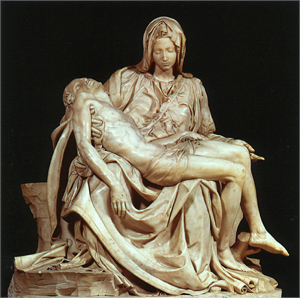
Some people say that the Pieta is the most beautiful art piece in the world. I agree
Discussion Question:
Share your reactions to the Pieta. |
#350. The Burial of Jesus
Matthew 27:57-61, Mark 15:42-47, Luke 23:50-56, John 19:38-42
The following verses are a harmonization of Mark and John.
- When evening had come, and since it was the day of Preparation, that is, the day before the Sabbath,
-Joseph of Arimathea, a respected member of the council, who was also himself waiting expectantly for the kingdom of God, went boldly to Pilate and asked for the body of Jesus. “He is mentioned in all four Gospels in connection with the burial of Jesus, but nowhere else in the New Testament. There is every reason to think that the reminiscence of his role in the burial is historical, since there was no reason for inventing him. … Arimathea, which Luke 23:50 calls a ‘town of the Jews,’ was his birthplace or former residence; but his role in the Sanhedrin and the information that he owned a tomb outside Jerusalem (Matthew) suggest that he was now a resident of the Holy City.” (Brown, JOHN, V. 2, p. 938)
-He was a disciple of Jesus. (Matthew and John) This is the highest compliment that the Biblical authors could say about a person.
-But secretly for fear of the Jews. (John) Yet Joseph was not public about being a follower of Jesus. Nor was Nicodemus whom we met Jesus in John 3.
-He was looking for the kingdom of God. (Mark and Luke) That is a mark of a true disciple: True disciples are always looking for God’s presence and reign in our lives.
-He was a good and righteous man who had not consented to their purpose and deed. (Luke only). The fact that Joseph had stood up for Jesus and not consented to the instigations of the high priests indicates an enormous strength of character within him.
-Then Pilate wondered if he were already dead; and summoning the centurion, he asked him whether he had been dead for some time. Pilate was still in his headquarters and still wondering about Jesus, wondering if Jesus was dead. Pilate sent a messenger to the centurion to ask him for the details about whether Jesus had actually died. Joseph of Arimathea had to wait while the messenger ran to get the information.
-When he learned from the centurion that he was dead, he granted the body to Joseph.
-Then Joseph bought a linen cloth (shroud), and taking down the body, wrapped it in the linen cloth (shroud), and laid it in a tomb that had been hewn out of the rock. This linen shroud becomes one of the most famous religious relics in the Catholic Church. “The shroud is about fourteen feet in length and less than four feet wide. Stains on the cloth possess the quality of a photographic negative; and when photographed, they yield a positive image of a human form. A medical analysis has led some to conclude that for a few days only the Shroud was folded lengthwise over a body that had been buried with aloes—a body that had been scourged, crowned with thorns, pieced with nails as in crucifixion and had the heart opened after death. The lineage of the Shroud can be traced back to 1353 and the church of Lirey in Troyes, France, but we hear of a similar shroud in a century earlier in Constantinople. … There is really no ancient papyrus support for understanding the term to refer to strips of cloth and there is no evidence that the Jews wrapped their corpses with bands or similar strips to those used by Egyptian mummies.”
(Brown, JOHN, V. 2, p. 942.)
We will examine the images on the Shroud of Turin in the next lesson on the resurrection. Remember how important the linen shroud is to the story of Jesus’ burial.
- Nicodemus, who had at first come to Jesus by night, (John) We had previously met Nicodemus in John 3:1 and 7:50. Nicodemus was a member of the ruling Sanhedrin. Two leaders and members of the Sanhedrin united in their task of burying the body of Jesus.
-Also came, bringing a mixture of myrrh and aloes, weighing about a hundred pounds. The number is excessively large.
-They took the body of Jesus and wrapped it with the spices in linen cloths, according to the burial custom of the Jews. (John) All four gospels recall the use of spices and linen clothes.
-Now there was a garden in the place where he was crucified, and in the garden there was a new tomb in which no one had ever been laid. (John) The location of the garden was near the place of execution. Matthew and John mention a “new” tomb. This location of the garden is also the location of an ancient quarry. Notice the trench in front of the tomb in which a circular stone could be rolled.
The photograph below is a great photograph of a reconstruction of Jesus’ tomb. A problem with the reconstruction is that the door is a normal height for visitors to step through, whereas in the story of the resurrection, the disciples/Mary Magdalene are consistently “stooping” to look inside or go into the tomb. The entry to the actual tomb seems to have been much lower than the reconstructed entry door. We learn from archeological data (via Raymond Brown) that the entrance to graves in caves was about three feet high.
Notice the trench in front of the door. The trench in front of the door has been compared to a “sliding door” or “gliding door” in one’s house. Such doors slide or glide along a track. So it was with a three foot, circular rock slab to protect the entrance to the grave. (Raymond Brown, JOHN, V. 2, p.982 )
Examine the following website for good information about the proximity of the Garden Tomb to Golgotha and a quarry.
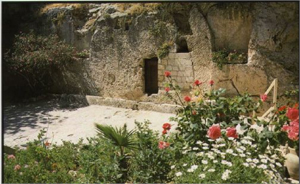
http://www.ida.net/users/rdk/ces/Garden_tomb.html
In the picture below, notice the inside of the tomb which has been carved out of limestone. Many scholars believe that this may be the actual tomb of Jesus or a similar tomb to Jesus burial vault. Jesus’ vault was carved out of limestone.
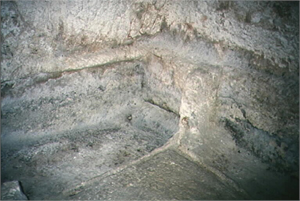
“This is Golgotha as seen from the walls of Jerusalem. We see the proximity of the hill of Golgotha which was part of the ancient temple quarry site. The busy nature of this place has not changed in thousands of years. Today it is an Arab bus station. Hundreds of passers by go through this place every day, most of them taking no notice of this sacred place.”
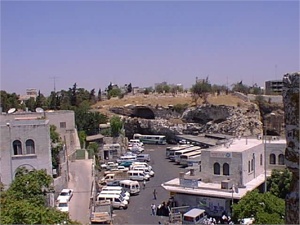
-And so, because it was the Jewish day of Preparation, and the tomb was nearby, they laid Jesus there. (John) Write the word, “Friday,” near the phrase, “day of preparation.”
-He then rolled a stone against the door of the tomb. Circle the word, “he.” Joseph of Arimathea was strong enough to roll the circular slab of stone up against the door of the tomb by himself. Notice that the gospels of Mark and Matthew have a singular person, Joseph, rolling a stone in front of the door of the burial vault. Notice that the Gospel of John has two people, Joseph and Nicodemus, preparing Jesus’ body for burial. The Gospel of John uses the pronoun, “they.” As we agreed at the beginning of this course, variation in details between stories do not bother us but are consistently part of the record.
-Mary Magdalene and Mary the mother of Joses saw where the body was laid. Again, the second Mary is the Mary, the mother of Jesus, but she is referred to as the mother of Joses. We don’t know why she was not named as the mother of Jesus but only as the mother of Joses and Joseph.
#351. THE GUARD AT THE TOMB Matthew 27:62-66
The following section is only from Matthew. We will study this section in a later lesson about the resurrection stories in the Gospel of Matthew.
- The next day, that is, after the day of Preparation, the chief priests and the Pharisees gathered before Pilate and said,
-‘Sir, we remember what that impostor said while he was still alive, “After three days I will rise again.”
-Therefore command the tomb to be made secure until the third day; otherwise his disciples may go and steal him away, and tell the people, “He has been raised from the dead,” and the last deception would be worse than the first.’
-Pilate said to them, ‘You have a guard of soldiers; go, make it as secure as you can.’ So they went with the guard and made the tomb secure by sealing the stone.
Discussion Question:
For you, what is the most important part of the curcifixion story for you and why?
|

 Back to Top Back to Top
|
















